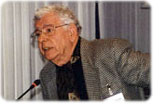Outlining the Future
Perspectives on Societal Development in the 21st Century
Workshop, March 23, 1999, CAP, Munich
Summary
Program
Participants
Word-Download: Executive Summaries, Program, List of Partipants.
|
Outlining the Future Perspectives on Societal Development in the 21st Century Workshop, March 23, 1999, CAP, Munich Summary Program Participants Word-Download: Executive Summaries, Program, List of Partipants. |
|||||
| |
Prof. Dr. Frederic Vester Society and Technological Change  In a world in which the growing amount of data and information leads to a previously unknown "density stress" the skill of analog thinking, of pattern recognition, will be indispensible. In exactly this area, noted Vester, mankind still has a lot to learn from nature. Without networked thinking, planning, and acting, without approaches that orient themselves to the structures and special dynamics of complex systems, we will never come to grips with our ever more complicated world. Complexity, however, requires a different view of reality from our accustomed one. We are an integral part of this complexity, so that all attacks on the envrionment, sooner or later, boomerang. The question, how we want to live in the future, shrinks to a question of how much leeway we have in the global system and how much modern technology can help us in this situation. Consensus between nature and technology is not a hopeless undertaking; they are not two divided worlds. Nature itself, a humanity along with it, is full of technologies that one can observe in the smallest units of life, from the anchors of proteins to the pincers of beetles. These are the true biotechnologies, abilities that have evolved and converged through unfathomable reaches of time, that have perfected themselves in the hard school of natural selection. From these biotechnologies, we can learn that even small changes in natural cycles leads to both positive and negative consequences. This complxity of consequences arises out of the simplest of systems, and can be detected without necessarily knowing the source of the change. Organizational bionics, a neglected part of information studies in Vester's view, can help not only to learn from the structures and techniques of living nature, but also to learn how natural systems develop and manage themselves. For example, the fact that evolution tends in the direction of declining energy use for the same function should be a clear clue for man-made processes. From this point of view, industrialization, with its dependency on increasing energy and material inputs, is a step backward in human evolution. The difficulties arising from this backward step are the natural consequence. Looking at humanity's newest development, microelectronics, Vester sees nature close at hand: little use of material, minimal use of energy, smallest possible amount of space, increasing capacity through combination and permutation. Unfortunately, computer designers are still concentrating on quantitative improvements rather than hunting qualitative change; they are building ever-better reptiles, unaware that the age of mammals is coming. |
||||
Project Background | Events | Reports and Essays Zukunftszeugen | Contact Us | Home Page Last Modified: 2002-04-23 TOP |
|||||